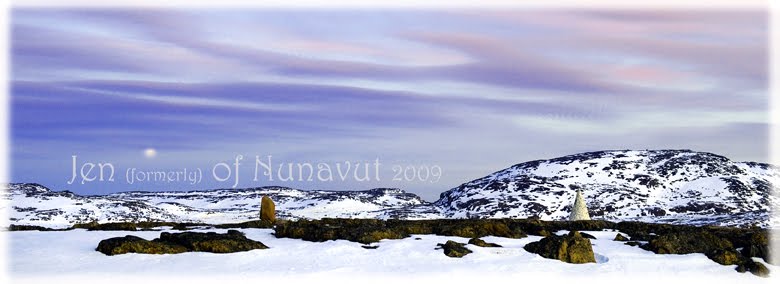 This is what's left of a stone structure from about 4,500 years ago. Maybe one of the oldest structures in Canada?
This is what's left of a stone structure from about 4,500 years ago. Maybe one of the oldest structures in Canada?The Tuniit, or Dorset Culture
(5,000 to 1,000 years ago)
The first people to arrive were the Tuniit. The archaeological remains of their camps begin to appear in Alaska shortly after 5,000 years ago, and they quickly spread across the western Arctic, Nunavut, and down the coasts of Greenland and Labrador. The tools and weapons which we find in their North American camps resemble very closely those used by northern Siberian peoples of the time, and the foundations of their tents were also arranged in a typically Siberian pattern, marked by a mid-passage of stones flanking a central fire-box. We think that the earliest Tuniit brought with them two items of technology which allowed them to quickly occupy arctic North America: the bow and arrow, which may have reached America for the first time in their hands, and finely tailored skin clothing similar to that still used by the Inuit and northern Siberian peoples. Until about 1,000 years ago, the Tuniit (or as archaeologists call them, the Dorset Culture people) were the sole occupants of most of arctic Canada.
(Nunavut99-The early years)
Here you can see a row of these fallen structures. The are like big pits with an entrance, only one was half intact and I have to wonder if someone recently may have put it back together.
Tallinn going through what we believe would be an entrance to this structure. They were either very small people or crawling was involved.
Rachelle looking very prominent as our team guide and captain, we wouldn't have found this place without her speediness over rocks and her little pirate map on the back of some scrap of paper! Good job Rachelle! Oh and we also wouldn't have gotten back if she hadn't arranged for us to be picked up by a boat, because by the time we got back it was high tide! Here is to not being marooned!
The Team, minus myself and Tallinn.
I look happy but reality is that I couldn't live here, and not because the door is made for an Oompa Loompa, but because there is no wireless!
.jpg)





.jpg)





3 comments:
This post was very cool! Very cool indeed. Although I am quite disapointed that there is no NEW post for TODAY! How could you do this to me? *tear*
Jen, your article is not even close to being a so called "History Lesson" for many reasons. But I digress, let me tell you that I am an Inuit, my tribe has in fact lived among the Tuniit people before their supposed extinction. Now back to the point; 1. The Tuniits were naturally very muscular and even considered to be giants in some cases 2. In arctic areas ancient people used crawl holes instead of doors to prevent heat escaping 3. You called the Tuniit people "Oompa Loompas" last time I checked they were a fictional character from a children's movie
The Tuniit were likely early Europeans by the descriptions and myths told by the Inuit. Which would not surprise me since The Dorset,Thule, Inuit and even the Clovis were not the first natives here. The Clovis to whom all native Indians are related got here 13000 yrs ago
The Solutreans were here prior to all native cultures in north america. They came here before or during the last ice age over 23,000 yrs ago from what is now France .
They were Pre-Germanic hunter gathers that traveled along the ice bridge when the north Atlantic was frozen hunting sea animals reaching all the way down to Florida.
This was proven by Dr.Denis Stanford and Prof.Bruce Bradley, At the Smithsonian institute.
The Tuniit were likely ancestors of the earlier Solutreans migration.
As far as central and south america is concerned The Clovis also were not the first people. Thor Heyerdahl Proved by travelling Ocean currents that Polynesians have been traveling back and forth across the pacific to Peru and Chile for as much as 14,500 yrs ago. That's more than a 1000 years before the Clovis.
Some evidence also suggest that Australian Aborigine and ancient Africans may have also been here 15,000 yrs ago.
Post a Comment